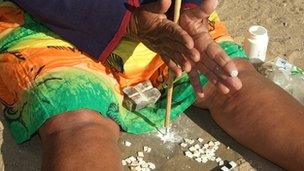'Earliest' evidence of modern human culture found
- Published

Artefacts of the San material culture, such as beads, have been dated to 44,000 years old
The earliest unambiguous evidence for modern human behaviour has been discovered by an international team of researchers in a South African cave.
The finds provide early evidence for the origin of modern human behaviour 44,000 years ago, over 20,000 years before other findings.
The artefacts are near identical to modern-day tools of the indigenous African San bush people.
The research was published yesterday in <link> <caption>PNAS</caption> <url href="http://www.pnas.org/content/early/2012/07/23/1204213109.abstract?sid=966d5de8-cc5f-452d-8abc-d5fd2d4ac607" platform="highweb"/> </link> .
Modern Living
Although 75,000-year-old evidence for human innovation has previously been found in southern Africa, the meaning of these artefacts has been difficult to interpret.
"These were things that seem symbolic, but there's no direct link to those people. We don't know what they were thinking," explained co-author <link> <caption>Dr Lucinda Backwell</caption> <url href="http://www.wits.ac.za/staff/lucinda.backwell" platform="highweb"/> </link> of the <link> <caption>University of Witwatersrand in South Africa</caption> <altText>University</altText> <url href="http://www.witz.ac.za" platform="highweb"/> </link> .
These new discoveries, however, <link> <caption>resemble modern day tools used by San hunter-gatherers</caption> <url href="http://www.pnas.org/content/early/2012/07/23/1202629109" platform="highweb"/> </link> so clearly as to remove any doubt as to their purpose.
"You can hold [one of the] ancient artefacts in your left hand and a modern artefact in your right and they're exactly the same. It's incredible… the functions are very, very clear," Dr Backwell told the BBC.
First poison
Dr Backwell and her co-authors describe notched decorative bones, arrowheads, warthog tusks possibly used as spear heads and the first recorded use of beeswax - to attach arrowheads - in their research.
She explained how one of the most spectacular finds was originally thought to be a broken arrow, but only by looking at modern tools of the San people at Johannesburg's Museum Africa did they realise its true use.
"We had found this long stick that had lots of intentional notches on it… we opened up one drawer and found a whole row of these things with labels on saying 'poison applicator'," she said.
The organic material, including the poison which is extracted from castor beans, was spectacularly preserved due to the arid conditions within the cave.
Although the material had first been found by co-author Dr Peter Beaumont in the 1970s, the advent of "micro"-analytical technologies allowed the team to identify remnants of sap from yellowwood trees - to attach stones to weapons - and traces of poison on the applicator.
The appearance of the organic material, although a substantial finding, has led the researchers to ask more questions.
"There's an internal evolution of the San people making stone tools, but when it gets to the organics a whole bunch just arrives at 44,000. There's clearly a different rate of cultural change in the different materials they used. But we can't really explain that," Dr Backwell explained.
- Published26 July 2012
- Published26 July 2012
- Published2 November 2011